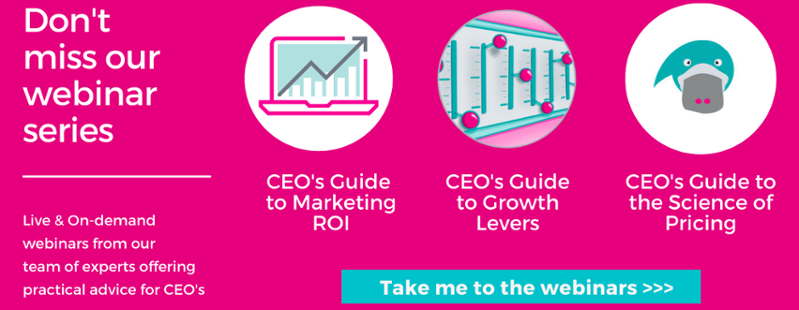When you’re a multinational corporation, the marketing world is your oyster. Want to generate brand awareness? Invest in a few peak time TV ads on ITV for £30k a pop. Or take out a colour double-page spread in The Times for £42,000. If you’re thinking bigger, why not shell out $5.25 million on a 30-second Superbowl advert? How about all of the above? However, very few of these “big business” marketing tactics work for smaller companies with tighter budgets.
Account-based marketing (ABM) is different. The approach of aligning sales and marketing to focus energies on a few accounts rather than a broad segment is one that medium-sized businesses can easily adopt. And according to specialist services marketing association ITSMA, 85% of marketers have found that account-based marketing delivers higher ROI than any other marketing approach. It’s probably why you’ve heard more and more of your peers talking about it of late.
That doesn’t mean it’s right for everyone though. Here, we’ll define exactly what account-based marketing is, and ascertain whether or not it’s right for your business. Let’s start with the basics.
What is account-based marketing?
Account-based marketing is a strategic, coordinated B2B sales and marketing approach, which treats a single account (or group of accounts) as a market of one.
If you want to land a whale i.e. a large, important customer - ABM can define, find, win and keep high-value prospects by appealing to their specific wants, needs and personalities. You plan marketing activities around a defined target or group of targets - aiming materials and messaging at specific stakeholders within the business or businesses.
- You may like: Five steps to 5x your sales pipeline in 3 months
It is not meant as a replacement for other marketing activity. It is an approach that can work well if you’ve got a big target in mind, or a few similar businesses, but it is not a replacement for brand activity, inbound lead generation or sales activations. It is another string to the bow, not simply a replacement bow.
The different types of account based marketing
There are three established techniques in ABM, which start with an incredibly narrow marketing focus, and widen the net slightly to target a larger audience. The key to each of them, however, is focus.
1:1 – As the name suggests, one-to-one ABM is the ‘purest’ form of account based marketing. This approach involves gathering a lot of data and insight on one or two specific accounts and devising marketing campaigns and materials that play specifically to them. This means that rather than targeting ‘CFOs in manufacturing businesses’, you’re targeting Geoff or Sandra from Company X. Your research is not general, it’s highly specific to that one person.
1:few – While one-to-one ABM targets one or two accounts, the 1:few approach spreads your bets somewhat, targeting around five to twenty accounts. This means looking at specific clusters of accounts with common traits. Given the lower risk involved, this tends to be the gateway into account-based marketing for those looking to test the waters a little before ‘going all in’. The enterprise division of O2 recently trialled a 1:few ABM campaign aimed at raising the profile of its newly-diversified ICT portfolio. By ignoring big brand campaigns and focusing on a few clients, O2 smashed their targets by 325%.
1:many – Often also referred to as programmatic account-based marketing, 1:many generally uses software to tailor and personalise campaigns at scale. This approach is more commonly aligned with traditional marketing as it targets hundreds of accounts. Rather than personalising for a few accounts, 1:many aims to personalise marketing messages for a vast number of people. To do that well, however, usually requires a significant investment in software and tech that can deliver personalisation at scale. For that reason, it might be out of the reach of smaller businesses, but medium-sized concerns could still benefit.
It’s tempting to read those examples and decide that ABM is right for all businesses. But as with all marketing strategies, tactics and approaches, what works for one may not work for others. So is it right for you?
Is it right for my business?
Each business and each market will play to different crowds and will require different approaches, so you should always examine your circumstances before acting. So when does ABM work, and when does it not?
ABM works if:
- You have a clear idea of the individual accounts you want to win.
- The Decision Making Unit (DMU) in your target audience refers to the individuals who make up the buying decision process and is often more complex the larger the company is.
- You only need to land a small number of large clients for your business to be successful.
- You get a lot of high-value RFPs (request for proposals), often also called “bids” or “tenders”. In marketing, these are the documents presented to marketers and salespeople detailing what is expected of them.
- A lot of your revenue tends to come from a few key accounts, and so it is imperative that you retain and grow the accounts you currently already count as customers
ABM won’t work if:
- You don’t have the budget, resources or patience to do it properly. Remember, it can be demanding, particularly if you’re going after a particularly ‘big whale’ and you know you’ll struggle to compete with the competition.
- You don’t have a clear understanding of whom you’re targeting and don’t have the resources to gather the requisite amount of data on them.
- You’re a B2C company selling lower value products to many consumers.
- The success of your business depends on the acquisition of a high number of small accounts.
- Your sales and marketing teams are not prepared or equipped to work closely together, as an account based marketing approach requires constant communication and cooperation between both teams. (By the way, if sales and marketing are not working well together you need to resolve this in any case).
- Senior members of the business aren’t bought into the process. ABM isn't a quick fix and will take time to produce results. Therefore, you need executive buy-in to give it the time it requires.
Conclusion
Account based marketing allows for the kind of relevant and highly targeted sales and marketing tactics that will make your business stand out to potential customers. It shows that you’re willing to go above and beyond and this can lead to businesses getting higher value opportunities earlier and significant ROI gains from their campaigns. 




